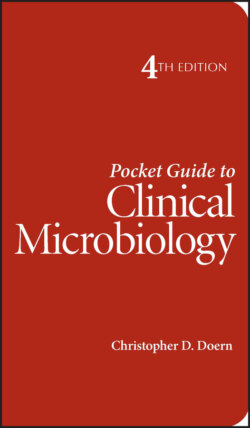Читать книгу Pocket Guide to Clinical Microbiology - Christopher D. Doern - Страница 10
Оглавление
Preface
The Pocket Guide to Clinical Microbiology is unique among reference texts in that its primary purpose is to present usable information in a concise and accessible manner. Now in its fourth edition, this iconic text has remained popular over the years because it has successfully condensed most of the information needed by the practicing clinical microbiologist into a pocket-sized guide. As Dr. Patrick Murray articulated in the preface of the third edition, with each iteration of this text the format has been honed to enhance its usability. Although the overall format of the fourth edition remains true to the template of previous editions, this edition reflects the tremendous evolution that has occurred in clinical microbiology over the past decade. In particular, three key advances have reshaped the practice of clinical microbiology, and have therefore, reshaped this edition.
First, the widespread adoption of matrix-assisted laser desorption/ionization time-of-flight mass spectrometry (MALDI-TOF MS) for organism identification has altered the way many laboratories practice clinical microbiology. Despite the fact that those using MALDI-TOF MS are less dependent on biochemical reactions to identify organisms, understanding biochemical profiles is still required for the troubleshooting of failed or ambiguous MALDI-TOF MS identifications. As such, this text has updated, but maintained, much of the biochemical reactions required to identify organisms the “old school” way. It is my belief that understanding and using these reactions to confirm organism identifications, remains one of the foundations of good clinical microbiology. This pocket guide should provide quick reference to everything the microbiologist needs to confidently identify most organisms encountered in the clinical laboratory. In addition, new information has been added in Section 8 that outlines the specifics of MALDI-TOF MS performance for individual bacteria, mycobacteria, and fungi.
Second, the development of molecular techniques has revolutionized the diagnosis of infectious diseases. Most notably, nucleic acid amplification testing (NAATs), also referred to as polymerase chain reaction (PCR), has drastically changed the practice of clinical virology to the extent that many laboratories no longer perform viral culture. Information regarding viral culture has been retained in this guide for labs still performing those techniques, but significant additions have been made throughout this edition to reflect the use of molecular diagnostics. Also, because gene sequencing is now a common technique used to identify bacteria and fungi, Section 8 contains new information to help interpret these results.
Third, the continued emergence of antimicrobial resistance poses significant challenges to clinical microbiologists as we struggle to provide treatment options for increasingly difficult-to-treat organisms. To reflect this reality, significant changes have been made to this pocket guide to help the microbiologist better perform and interpret antimicrobial susceptibility testing in the era of multidrug resistance. Acknowledging the international appeal of this text, I added new tables outlining guidance provided by both the Clinical and Laboratory Standards Institute (CLSI) and the European Committee on Antimicrobial Susceptibility Testing (EUCAST). The goal of these tables is to help the reader easily understand what methods can be used, and what interpretive criteria exist, for most organism/antibiotic combinations. Also included are tables with important intrinsic resistance profiles for commonly encountered organisms, as well as key mechanisms of resistance.
Sir Isaac Newton once said, “If I have seen further than others, it is by standing on the shoulders of giants.” Although I have no illusions that I have “seen further” than anyone else, the humility expressed in this quote resonates with me as I have undertaken the task of updating a text that was conceived and authored by Dr. Patrick Murray, one of the true giants of clinical microbiology. So first and foremost, I thank him for his work making this pocket guide the respected resource that it is. I hope that the fourth edition will do justice to the tradition of this text. In addition, I want to thank the talented, and patient, professionals at ASM Press. Specifically, Christine Charlip and Larry Klein, along with what I'm sure are countless others at ASM, warrant special thanks for all their work. And last, I thank my wife Kelli, who provided support and under-standing through the many late nights and weekends it took to complete this project. I could not have finished this project were it not for her support.
The practice of clinical microbiology is a wonderful discipline, requiring judgement, investigation, and critical decision-making to produce quality results. It is my hope that you will find this pocket guide to be a user-friendly reference that enhances your ability to do all of these things, and ultimately provide the best patient care possible.
Christopher D. Doern
